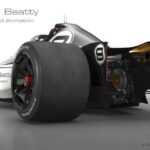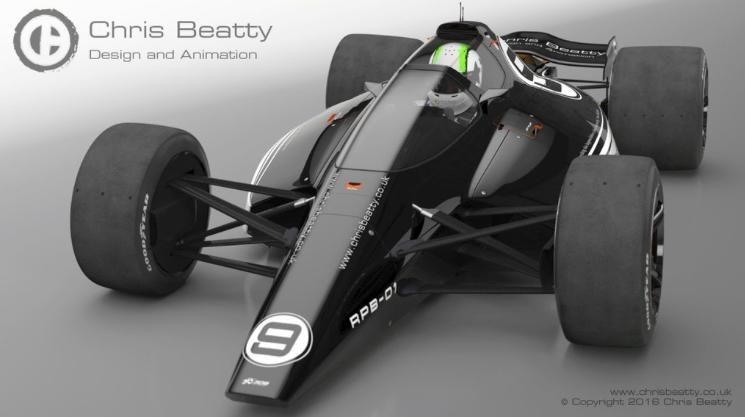IndyCar must incorporate electric into its next engine
 |
| Next Generation IndyCar concept |
The automotive world is going 100% electric – it's just a matter of time – and our environment will be far better because of it. However, that poses a real dilemma for motorsports. Not only do silent electric motors strip away the thrilling power and pulsating sound a traditional racing engine, they will likely not won't store enough battery to enable a car to run 500 miles at over 200 mph for well over a decade or more.
So what's the solution? How can sanctioning bodies like IndyCar, NASCAR or F1 maintain some level of excitement, enable cars to run over 200 mph for 500 miles, and still remain relevant to the automotive industry and the charge toward 100% electrification?
For the purposes of this article, I will address the challenge for IndyCar in particular because running 500-miles at over 200 mph on the high speed ovals with a car that has no room to carry a large enough battery to do that is, today, impossible.
[adinserter name="GOOGLE AD"]To start, no one can argue that a screaming normally aspirated engine isn't exciting. Therefore, I am recommending that IndyCar remove the turbo and add 2-cylinders along with extra displacement to make up for some of the lost torque, but not all of it. This formula will restore a thrilling sound to the car, bringing fans back to the race track in droves. Further, going 500-miles at over 200 mph will not be a problem – same as today, you stop for fuel.
But is a 3-liter normally aspirated V8 engine relevant to today's passenger cars? For the most part no, though V8s are still sold. But whoever said racing had to be 100% relevant to passenger cars? If it was, racing would become so boring it would become extinct quickly. It's more important that racing is exciting, has a large fan following, which in turn delivers good exposure to the engine manufacturers in the series – today Honda and Chevy.
But how does that solve the need for manufacturers who want to go 100% electric? Well you cannot today, and probably won't be able to for a very long time until Graphene Ultracapacitors replace today's Lithium Ion batteries. Graphene Ultracapacitors can recharge very quickly with high voltage power supply, making recharging during a tire change feasible – someday. Just not today.
So how does IndyCar work electric into their powerplant today? The same way F1 did years ago – with KERS – Kinetic Energy Recovery System.
KERS would replace the push-to-pass HP increase that the turbo provides today. The driver would have to manage the energy stored in order to maximize their pushes-to-pass.
On road courses where there is a lot of braking, some kinetic energy can be recovered to recharge the battery, but on high-speed 100% throttle ovals the driver never brakes, so kinetic energy recovery would be impossible – right?
Not exactly.
As we have been recommending for a long time, IndyCar should take most if not all the wings off the car and let the drivers have to brake for the corners. At high speed ovals like Indy, cornering speeds will be down, straightaway speeds up, and kinetic energy recovery possible, because the driver will be braking multiple times per lap.
Except for the 3-liter normally aspirated engine, which would be unique to every manufacturer, the car, including the KERS system, should be 100% spec.
That statement is sure to make knots in the panties of those who believe variety makes racing more appealing. However, after studying this sport for a long time, I have come to the conclusion that in order for racing to ever be considered a true sport to the general population, the driver has to be a much larger part of the equation.
And with a ‘spec' car you do just that (plus you reduce cost). IndyCar drivers should not be winning races because they have Team Penske's exclusive shocks. Team Penske's superior shocks do not attract even a single additional fan to the races.
 |
| Next generation IndyCar conceptAnd with a ‘spec' car you do just that (plus you reduce cost). IndyCar drivers should not be winning races because they have Team Penske's exclusive shocks. Team Penske's superior shocks do not attract even a single additional fan to the races. |
Whoever had the idea to allow the teams to develop their own shock package was dead wrong. It costs a lot of money with 0.00% return on investment from a series popularity perspective. The shock programs must be abandoned immediately.
Taking it to the extreme – F1 allows a huge amount of engineering design by each team. The result? If you are not driving a Mercedes you cannot win. The driver is essentially nothing. F1 today isn't a sport, it's a great exercise in engineering.
While engineering variety interests many people, it's certainly not a sport. To be a sport, the skill of the human must make a difference.
The definition of sport is “an activity involving physical exertion and skill in which an individual or team competes against another or others for entertainment." Notice it says nothing about, say, an engine's horsepower or any other outside crutch that masks the athlete's skill, or lack thereof.
So let's summarize what the next-generation IndyCar could be:
- 3-liter normally aspirated mind-blowing screaming V8 with 15,000 rpm limit
- KERS and small electric motor to replace today's turbo boosted push-to-pass
- State-of-the-art ‘spec' batteries to store the recovered kinetic energy that are part Lithium Ion and Part Graphene, eventually moving to 100% Graphene. The batteries should be state-of-the-art and push the envelope because advanced battery technology is the key to 100% passenger car electrification. The participating manufacturers, or their subsidiary or partner, shall jointly develop the batteries, sharing in cost but also sharing in the technology transfer to their respective passenger car divisions.
- Except for the engine, a 100% spec car to keep costs down, and driver skill requirements up
- Little to no wings
- Slightly wider tires
- Slightly larger underbody tunnels to replace some of the lost downforce due to the removal of the wings – some but not all, we want the cars to brake for the corners at places like Indy
- A car capable of doing standing starts – the high torque of the electric motor can help here and prevent the car from stalling, but use too much battery on the start and risk having less for push-to-pass later.
In summary, I feel this is the best compromise for IndyCar's future – it would make the sport more exciting while maintaining some relevance to the passenger car industry's
ever-increasing move to electrification.
Mark Cipolloni/AutoRacing1.com
